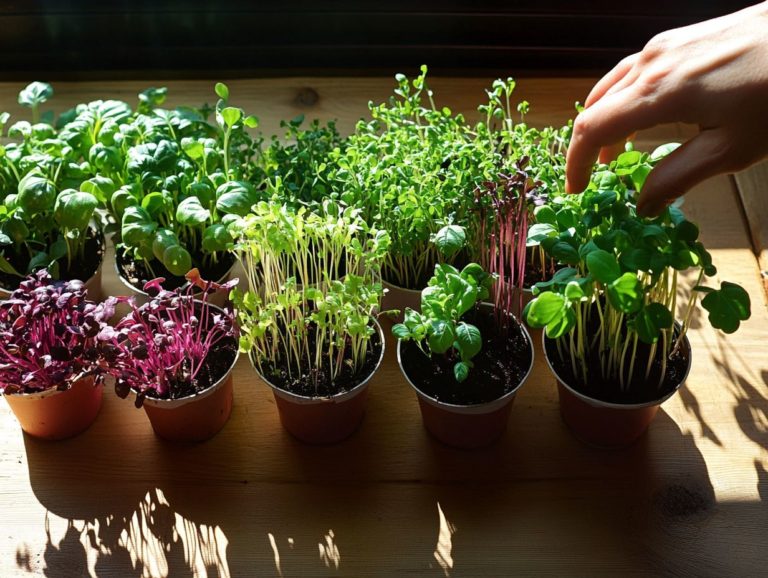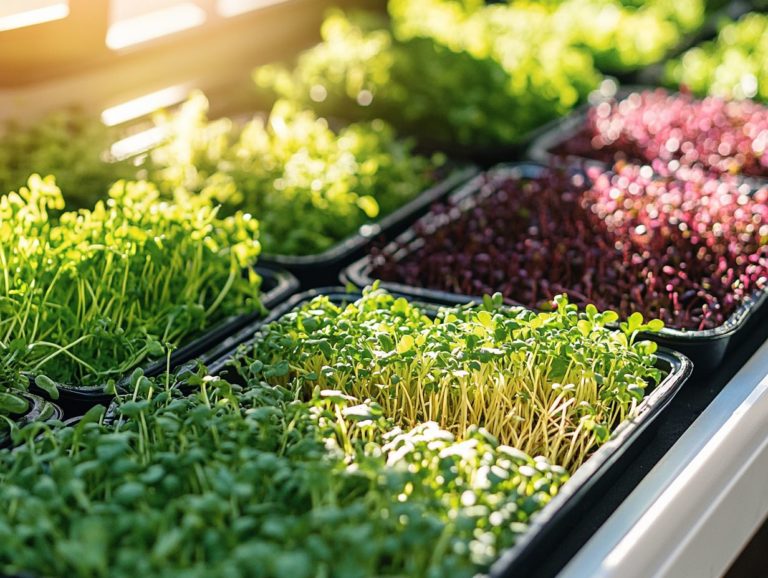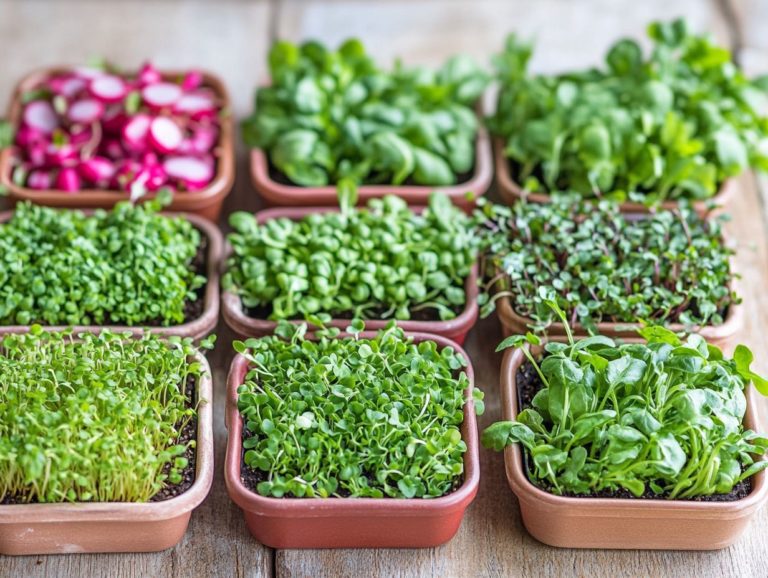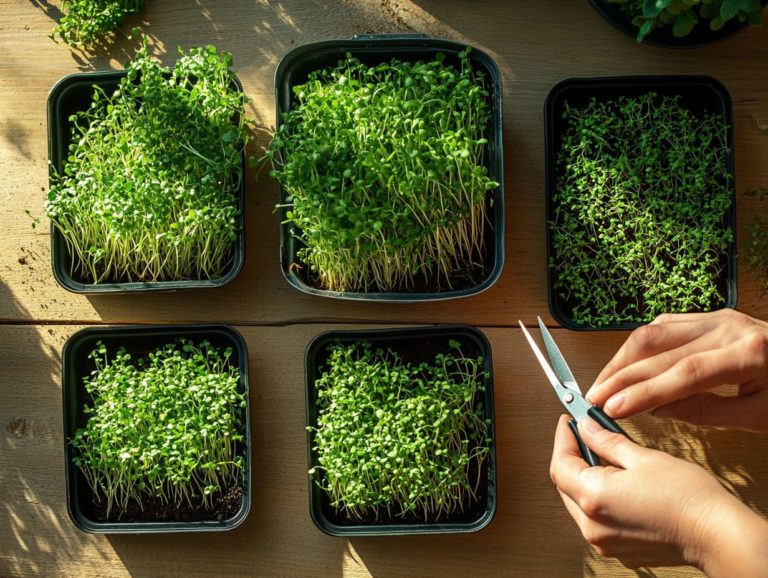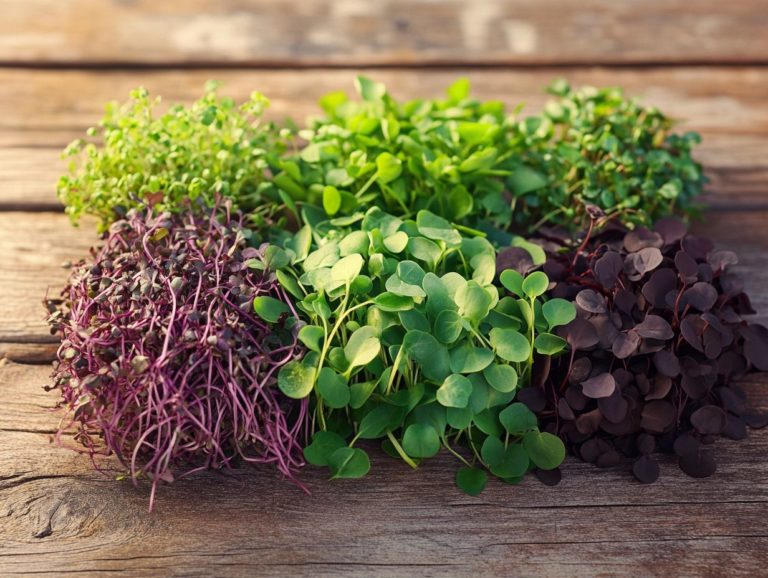The Role of Microgreen Varieties in Plant-Based Diets
Microgreens are not just tiny greens; they re little flavor explosions that bring an impressive nutritional boost to your meals. This article explores the many health benefits these miniature powerhouses offer, showcasing essential nutrients that can elevate your overall well-being.
You will learn how to easily add microgreens into a plant-based diet, discovering delightful ways to enhance your dishes and the perfect pairings that complement them beautifully. We will also discuss effective growing methods, such as hydroponic systems, how to select the right varieties like Swiss chard and amaranth, and vital safety precautions to ensure your microgreen journey is both delicious and secure.
Let s dive in and explore the amazing benefits of microgreens together!
Contents
- Key Takeaways:
- Nutritional Benefits of Microgreens
- Incorporating Microgreens into Plant-Based Diets
- Growing and Harvesting Microgreens
- Choosing the Right Microgreen Varieties
- Potential Risks and Precautions
- Frequently Asked Questions
- What are microgreens and how do they fit into a plant-based diet?
- What makes microgreens a valuable addition to a plant-based diet?
- What types of microgreens are most beneficial for a plant-based diet?
- How can microgreens be incorporated into a plant-based diet?
- Are there any potential drawbacks to incorporating microgreens into a plant-based diet?
- Can anyone consume microgreens as part of a plant-based diet?
Key Takeaways:
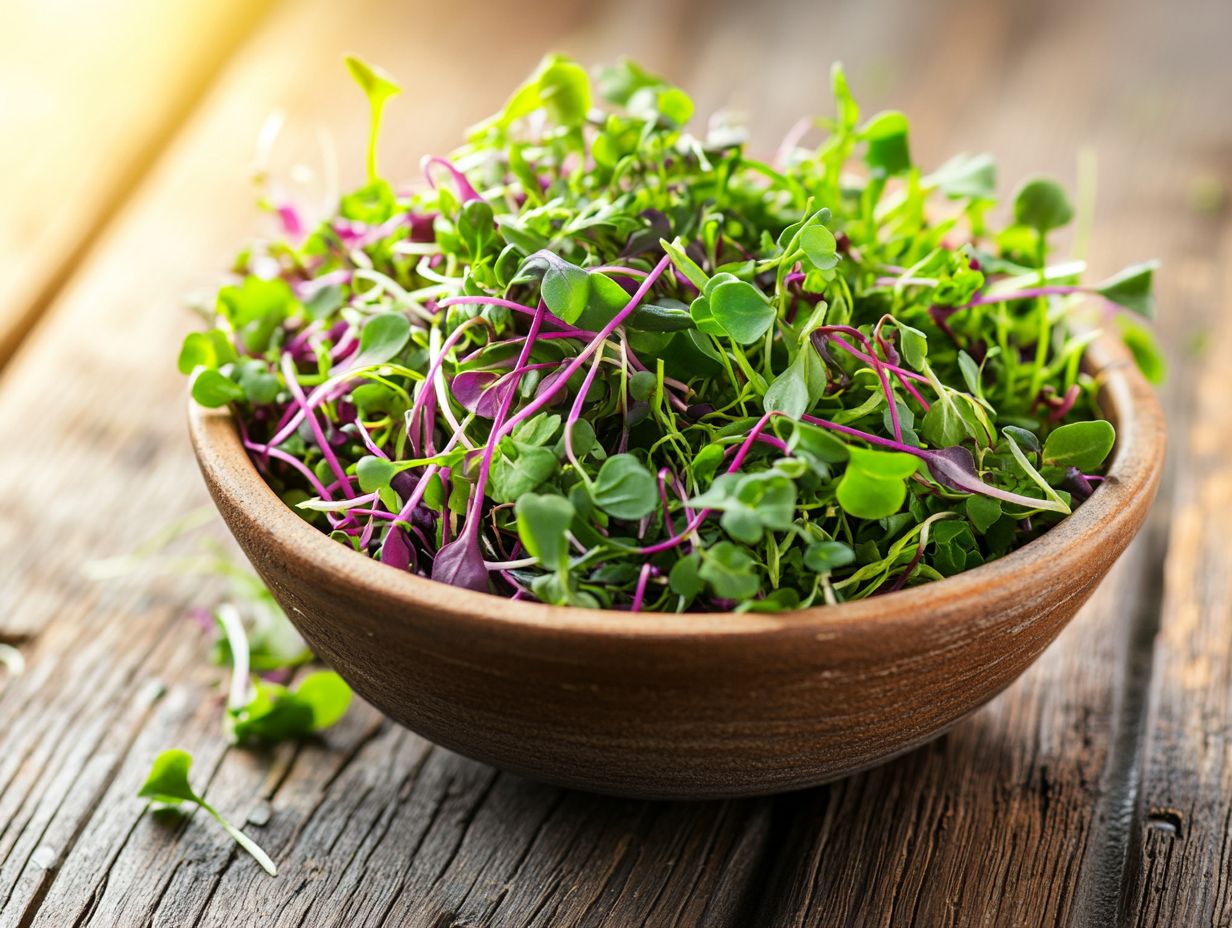
- Microgreens are packed with nutrients, making them a valuable part of plant-based diets.
- There are many ways to incorporate microgreens into meals, including using them as toppings, in smoothies, and in salads.
- When choosing microgreen varieties, consider taste, appearance, and growing difficulty for successful growth and optimal flavor.
What are Microgreens?
Microgreens are young plants harvested just after the first leaves have developed, and they belong to the delightful category of vegetable greens. Typically, you can harvest them within 7 to 21 days after germination. They come packed with flavor, nutrients, and vibrant colors.
Think of popular choices like broccoli, spinach, and fenugreek, which belong to various plant families, including the Brassicaceae family. These nutrient-rich greens grow well in small areas while gaining recognition for their potential health benefits, as highlighted by studies from esteemed institutions like the Cleveland Clinic.
Did you know these tiny greens can pack a powerful nutritional punch? They offer an impressive array of vitamins, minerals, and antioxidants, often boasting higher concentrations than their fully matured counterparts.
This extraordinary nutrient profile makes them a great addition to salads, sandwiches, and garnishes, enhancing both flavor and visual appeal. Some cultivars, such as radish and mustard microgreens, bring a spicy kick to your plate, while others like pea shoots provide a sweet crunch. To learn more about their health benefits, consider incorporating these greens into your meals.
Their versatility in culinary applications, combined with research suggesting benefits like improved heart health and reduced inflammation, secures their place in both food culture and wellness discussions. Incorporating a variety of microgreens into your diet can lead not only to enhanced meals but also to better overall health.
Nutritional Benefits of Microgreens
Microgreens aren’t just a delightful burst of flavor for your meals; they also boast an impressive range of nutritional benefits that elevate your diet to new heights.
Renowned registered dietitian Kayla Kopp notes that these petite greens are particularly rich in polyphenols, which are natural compounds that can help protect your cells. They are known for their powerful antioxidant properties that may aid in cancer prevention and combat iron deficiency.
The concentrated nutrients, packed with essential vitamins and minerals, play a significant role in your overall health, making them a must-have for anyone looking to enhance their plant-based eating habits.
Key Nutrients and Health Benefits
Microgreens are a treasure trove of key nutrients. They offer impressive health benefits that you’ll definitely want to try! Rich in polyphenols, vitamins, and minerals, these tiny greens fight cell damage, improve sugar levels, and support brain health in the fight against neurodegenerative diseases. Their high nutrient levels make it easy for you to elevate your nutrient intake while addressing common health concerns like iron deficiency. This makes them an ideal choice for anyone pursuing a balanced diet.
With an abundance of vitamins A, C, E, and K, microgreens truly serve as a powerhouse for promoting your overall wellness. Vitamin A is crucial for maintaining vision and boosting immune function. Meanwhile, vitamin C brings robust antioxidant properties that enhance your immune system and assist in collagen formation.
Vitamin E protects your cells from oxidative damage and plays a pivotal role in cardiovascular health. Vitamin K is vital for blood clotting and bone health, helping tackle issues such as osteoporosis.
High levels of iron found in certain microgreens can help combat anemia, making them a strategic addition if you re facing iron deficiency. This impressive nutrient profile not only boosts your physical health but also supports cognitive function, potentially reducing risks associated with conditions like Alzheimer s disease.
Incorporating Microgreens into Plant-Based Diets
Incorporating microgreens into your plant-based diet is an exceptional way to elevate both flavor profiles and nutritional content. They transform your meals into something truly exciting and healthful.
These nutrient-dense greens can easily be integrated into a variety of dishes, from vibrant salads to refreshing smoothies, enhancing not just taste but also health benefits.
As you embrace plant-based eating, microgreens present an effortless and flavorful solution for maintaining a balanced and healthy diet. Exploring the top microgreen varieties for health enthusiasts can cater to your diverse culinary preferences.
Ways to Use Microgreens in Meals
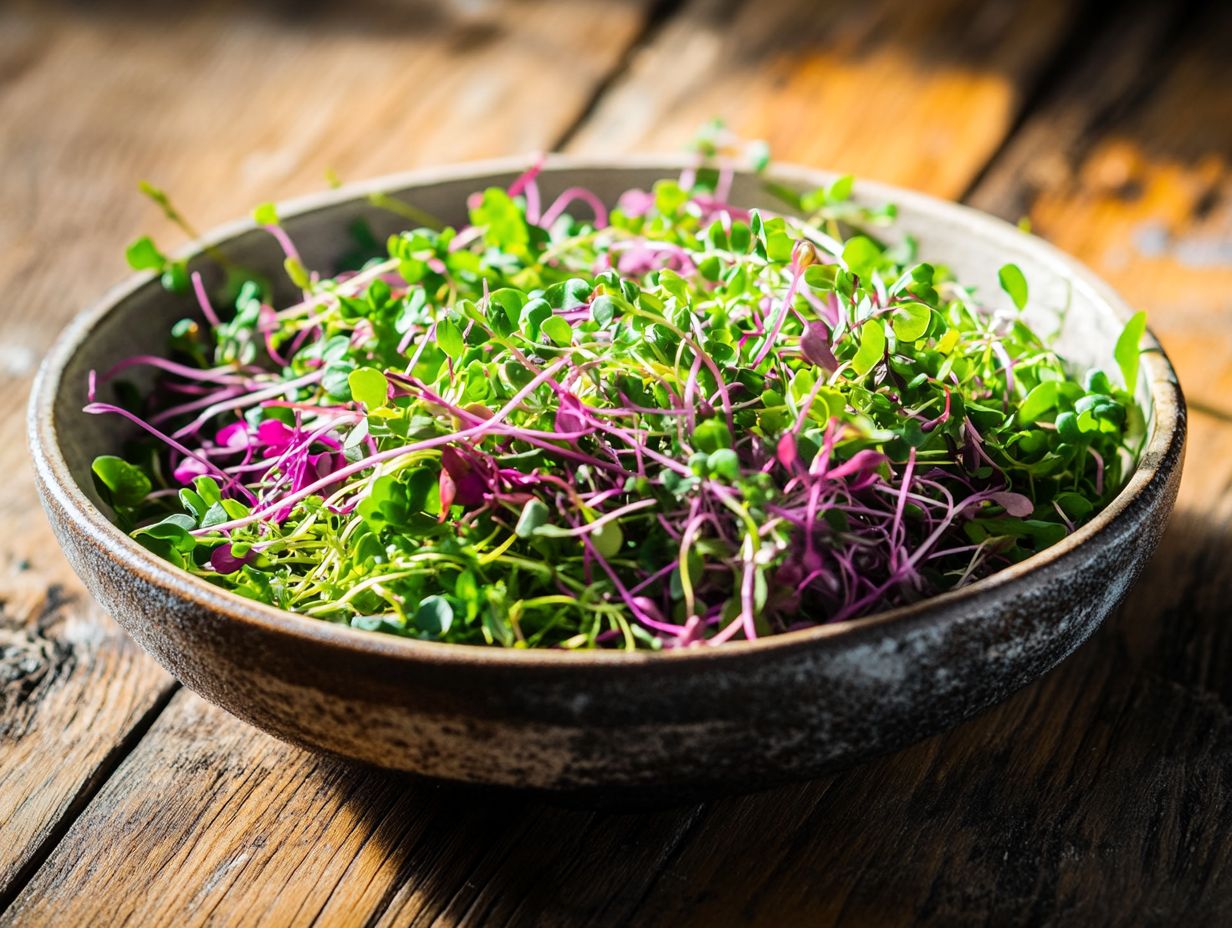
Imagine the delicious possibilities with microgreens in your meals! You can add them to salads, sandwiches, or wraps, or use them as garnishes for soups and entrees. Microgreens bring a burst of flavor that elevates ordinary dishes into extraordinary culinary experiences, making them essential for a healthy diet.
These tiny, vibrant greens come in an array of flavors, from the peppery kick of arugula to the delicate sweetness of pea shoots, perfect for enhancing various dishes. For example, you might sprinkle sunflower microgreens on a refreshing summer salad for a nutty twist or layer radish microgreens in a turkey wrap for an unexpected zesty pop. Additionally, exploring the role of microgreens in holistic health can provide insights into their nutritional benefits.
Take your morning routine up a notch by incorporating basil or dill microgreens into your omelets or smoothies. A simple tip is to keep a small container of assorted microgreens handy, allowing you to effortlessly enrich the taste and nutrition of any meal at a moment s notice.
Complementary Foods to Pair with Microgreens
Incorporating microgreens into your meals is a fantastic way to elevate both flavor and nutrition. Pair them with complementary foods like tempeh, quinoa, and an array of vegetables to create harmonious, nutrient-rich dishes. This thoughtful combination enhances your meal’s flavor profile while ensuring you enjoy a diet packed with essential nutrients.
For instance, adding vibrant microgreens like arugula or radish to a hearty quinoa salad introduces a delightful peppery crunch that beautifully balances the nutty flavor of the grain. When you pair these petite greens with roasted vegetables, they provide a fresh contrast that invigorates any dish. Including legumes like chickpeas or lentils can also amp up the protein content, making your meal feel more substantial. To learn more about their benefits, check out understanding microgreens and their health advantages.
The result? Dishes that are visually stunning and rich in antioxidants, vitamins, and minerals crucial for combating issues related to heart disease and improving your overall health and well-being.
Growing and Harvesting Microgreens
Growing microgreens is a truly rewarding venture that fits seamlessly into even the smallest spaces. It’s an accessible option for anyone passionate about sustainable food practices. These vibrant greens demand minimal resources and can thrive both indoors and outdoors. Enjoy the delight of fresh produce year-round while contributing to a lower environmental impact than traditional farming methods.
Get ready to enjoy nutritious and flavorful greens right at your fingertips! By employing the right techniques for cultivating and harvesting microgreens, you can elevate both your culinary creations and your overall well-being. Understanding the science behind microgreens and health will further enhance your appreciation for these tiny powerhouses.
Methods for Growing and Harvesting Microgreens
There are several effective methods for growing and harvesting microgreens, each offering unique benefits and ease of use. You can choose from traditional soil-based techniques or hydroponic systems growing plants without soil, using nutrient-rich water instead. This allows you to select the approach that best fits your space and lifestyle.
Once you ve nurtured your microgreens to maturity, harvesting them is a breeze. You ll yield fresh greens that elevate any meal while supporting sustainable food practices.
If you re using a soil-based method, selecting well-draining, healthy soil is crucial for promoting healthy seedling growth. Be mindful when watering your seedlings; careful attention prevents over-saturation. Excess moisture can lead to mold or root rot.
These petite plants thrive under bright, indirect sunlight or grow lights, which should be utilized for about 12-16 hours each day.
When it comes time to harvest, all you need is a pair of scissors. Cut just above the soil line once the leaves have developed their true form. To ensure top-notch quality, gently rinse the greens and store them in a cool, dark place until you’re ready to enjoy them, perhaps alongside a delicious recipe from Kayla Kopp.
Choosing the Right Microgreen Varieties
Selecting the right microgreen varieties is essential for enhancing both flavor and health benefits. You’ll find an array of options to suit your distinct tastes and preferences, particularly from the Brassicaceae family.
Consider popular choices from the Brassicaceae family, like broccoli and Swiss chard. They are celebrated for their impressive nutrient profiles and unique flavors, offering benefits such as polyphenols (natural compounds that can help manage cholesterol levels) that can help manage LDL cholesterol.
By familiarizing yourself with the various types of microgreens, you can effortlessly choose those that align perfectly with your culinary aspirations and nutritional requirements. For instance, exploring the top microgreen varieties for gourmet cooking can be particularly beneficial for those concerned about Type 2 diabetes.
Factors to Consider when Selecting Microgreen Varieties

When selecting microgreen varieties, consider key factors like flavor profiles, growth time, and nutritional content. Greens such as amaranth and quinoa provide unique tastes and potential health benefits. Others like spinach and fenugreek offer their own culinary advantages, particularly noted for their positive effects related to Alzheimer s disease.
Understanding these elements helps you choose microgreens that elevate your meals and align perfectly with your dietary preferences, including those following a high-fat diet. Exploring the role of microgreens in healthy eating can also enhance your nutritional choices.
Along with these considerations, the growth conditions you provide are crucial in determining which microgreens to cultivate. Factors such as light availability, temperature, and moisture can significantly influence the success of various varieties, as highlighted by sources like Cleveland Clinic and Medical News Today.
Regarding flavor versatility, think about how specific microgreens can enhance particular dishes. For instance, the delicate peppery notes of arugula microgreens beautifully complement a salad, while the sweet and earthy undertones of beet greens can elevate a vibrant stir-fry. To dive deeper into how these microgreens grow, consider exploring understanding the growth patterns of microgreen varieties.
Recognizing the health benefits associated with each type, like the high vitamin C content found in broccoli microgreens, can inspire you to make more mindful selections. Learning about the role of microgreens in sustainable eating ultimately leads to richer, more nutritious meals that complement a balanced lifestyle.
Potential Risks and Precautions
While microgreens are lauded for their impressive nutritional benefits, it’s crucial to recognize the potential risks and precautions associated with their consumption. Contamination can arise if safety measures are overlooked during the growing and harvesting process, potentially leading to foodborne illnesses.
Ensuring cleanliness and proper handling of microgreens is essential. Using sanitized equipment significantly mitigates these risks. This way, you can savor their health benefits with peace of mind and enjoy their role in a plant-based diet while understanding why microgreens are essential for a balanced diet.
Contamination Risks and Safety Tips
Contamination of microgreens can arise from various factors, such as improper growing conditions or handling. This makes implementing safety measures very important, especially in places like Jacksonville, where fresh produce is abundant.
These tiny plants, celebrated for their vibrant flavors and nutritional benefits, are particularly vulnerable to pathogens if not cared for meticulously. Start with high-quality seeds and sanitized equipment to ward off soil-borne contaminants, as recommended by reputable sources like PubliX.
When harvesting, use clean hands and tools to minimize the risk of cross-contamination. After harvesting, gently rinse the microgreens under cool water and dry them thoroughly before storing. Place them in a sealed container in the refrigerator, keeping them away from raw meats and other potential sources of contamination. This ensures they remain fresh for your meals.
Follow these practices to enjoy fresh microgreens with complete confidence, knowing you re making informed choices that benefit your health!
Frequently Asked Questions
What are microgreens and how do they fit into a plant-based diet?
Microgreens are young, edible plants harvested after just a few weeks of growth. Packed with nutrients, they can be added to a variety of dishes to enhance flavor and nutritional value, making them a perfect choice for health-conscious individuals.
What makes microgreens a valuable addition to a plant-based diet?
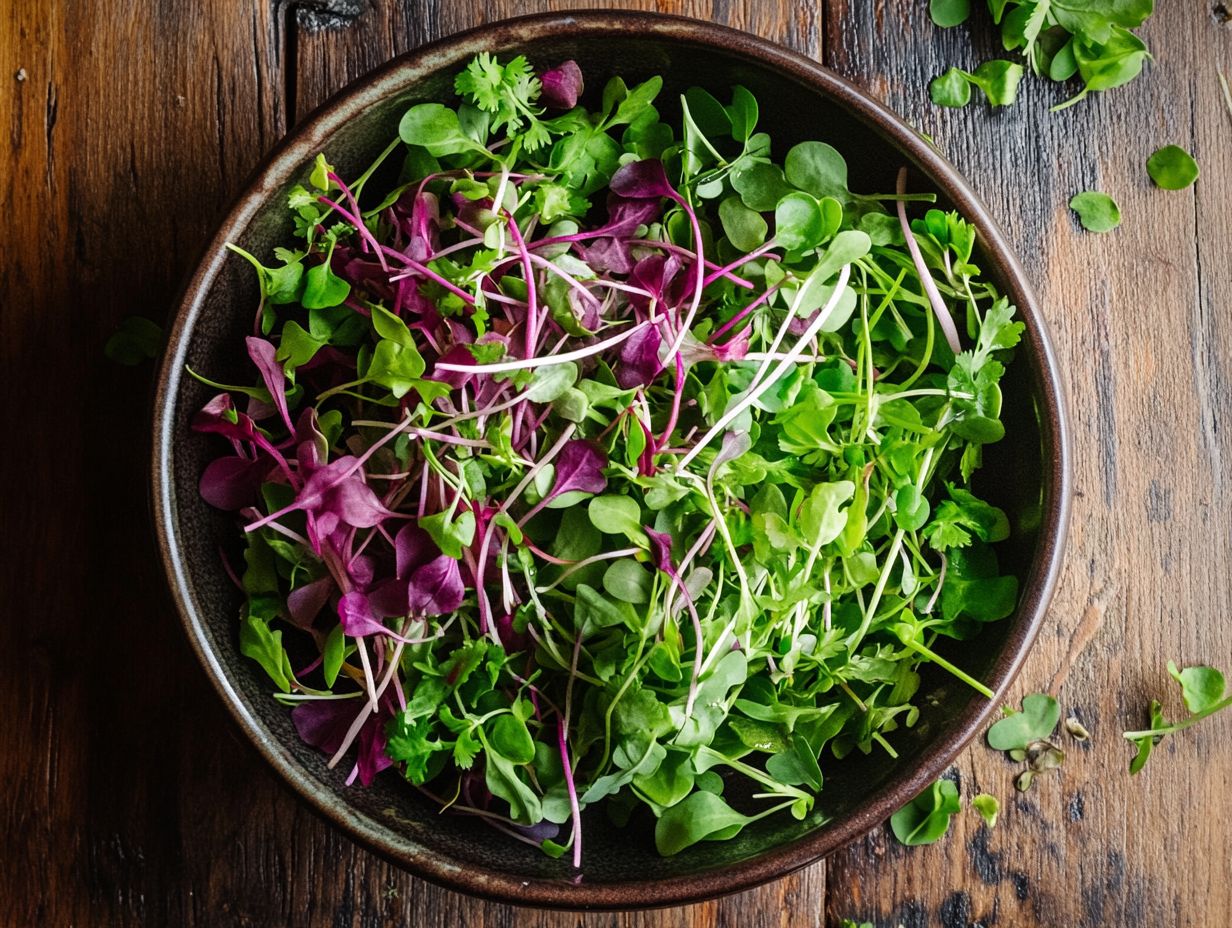
Microgreens are rich in vitamins, minerals, and antioxidants, making them an excellent source of nutrition for those following a plant-based diet. They provide a burst of flavor and texture to meals, which can help lower LDL cholesterol, a type of cholesterol that can be harmful in high levels.
What types of microgreens are most beneficial for a plant-based diet?
Some of the most beneficial microgreens for a plant-based diet include:
- Broccoli
- Kale
- Chia
- Sunflower
These varieties are high in nutrients and can add diverse flavors to meals. Their health benefits are well-documented by organizations such as the Cleveland Clinic.
How can microgreens be incorporated into a plant-based diet?
Microgreens can be used in various ways in a plant-based diet:
- Add to salads, sandwiches, and wraps
- Blend into smoothies
- Include in cooked dishes like stir-fries and soups
- Use as a garnish for extra flavor and nutrition
This versatility makes them especially appealing for those interested in managing conditions like Type 2 diabetes.
Are there any potential drawbacks to incorporating microgreens into a plant-based diet?
While microgreens are incredibly nutritious, they can also be quite expensive compared to other greens, particularly those from the Brassicaceae family. Some people might have digestive issues if they eat too many microgreens, so it is important to start with small amounts and listen to your body’s response.
Can anyone consume microgreens as part of a plant-based diet?
Yes, microgreens are safe for most people as part of a plant-based diet. They are young plants packed with nutrients.
If you have allergies or sensitivities to specific plants, research the microgreen before consuming it. Always check with a healthcare professional before making significant dietary changes, especially if you have conditions like Alzheimer s disease.
Microgreens are a delicious addition to your meals. Enjoy their vibrant flavors and health benefits while ensuring they’re safe for you!

